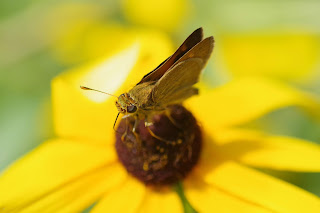I read something last night about milkweed tussock moth caterpillars, that they can defoliate a stand of milkweed fairly quickly, and thought about my lovely milkweed patch that I planted to attract monarch butterflies and host their caterpillars, and that I have not seen any monarch caterpillars on those plants, but suddenly have masses of milkweed tussock moth caterpillars. I would never considering doing anything to get rid of the milkweed tussock moth caterpillars; that's not how I approach nature. But today nature reminded me of what it can do about such a situation:
Too many caterpillars? No problem, a stinkbug can take care of that for you! I think this is an immature anchor bug.
It would appear that there is a mass molting going on. Some of them have their regular fluff, but others are kind of bare, and there are what are obviously shed skins around.
I think the bare ones have just molted and are waiting for full fluff.
Anyway, as I have always said, if there is something to eat, there will be something to eat it, and here were a lot of caterpillars to eat.
From what I observed, I think this bug killed a couple of caterpillars in a few minutes.
An adult anchor bug on another plant nearby
And speaking of molting...
The baby stinkbugs that hatched the other day were no longer on the leaf where they hatched (nor where their eggs), or so I thought until I looked at the underside of the leaf. They were not all there, but there were a few, and one of them has recently molted. You can see the skin it shed, the black spidery thing.
Backyard Bug of the Day:
Cricket
I am super tired, and this blog is NOT going to be done on time, which means I am going to be really late going to bed when I wanted to be early. I am feeling a bit cranky about that. The way I am going to handle it is to post all of the rest of today's pictures in the order I took them, rather than trying to group things in a better way. Other Bugs:
Monarch butterfly, female. She was on the milkweed patch, then flew to a purple cone flower, then flew here, and only let me get this close.
Bumblebee pollinating my tomato plant
Assassin bug nymph lurking.
Skipper
Some kind of longhorn beetle
Dragonfly
Small wood satyr. These are everywhere this year. And that's three butterflies I was able to photograph today!
This blog is often a misleading representation of what I saw in my backyard, and today that is definitely the case. I saw a LOT of bees and wasps. I don't have many pictures, but there were many species in the backyard today.
Katydid nymph
Hopper nymph
Early instar monarch
Plume moth and some kind of longhorn beetle.
It's amazing how fast monarch (or any) caterpillar grows:
In a few days I hope to see if these are monarch tussock moth caterpillars.
Damselfly
First white hickory tussock moth caterpillar of the year.
Flower longhorn beetle
Cricket
The first of the goldenrod is blooming. I think these are male and female of the same species of hoverfly.
Ants. Something, I don't know if it's the ants or something else, has eaten away at most of this Queen Anne's lace.
I know this just looks like a bit of fluff, but it's actually a bit of fluff on the back of a larva (possibly a lacewing larva).
Arachnid Appreciation:
.
.
.
.
.
.
.
.
.
.
.
.






































No comments:
Post a Comment